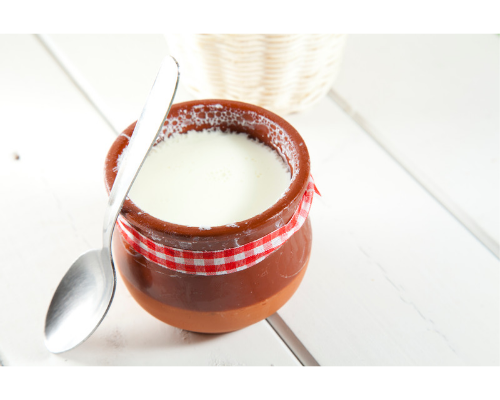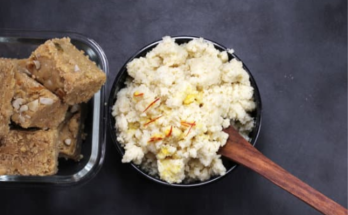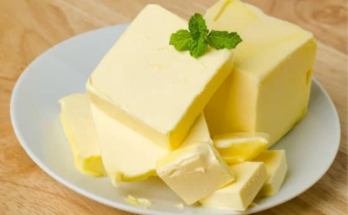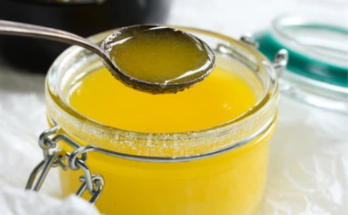Dahi (Curd) is reported to have a better nutritive value than milk. Though there is no increase in the fat or protein content of milk during fermentation, the digestibility of dahi is more than that of milk. The calcium and phosphorus contents of dahi are more easily assimilated. Dahi contains more vitamins than milk.
During curd formation, the lactose of milk is converted into lactic acid. There is some breakdown of protein increasing the nonprotein nitrogen. The fat globules coalesce and distribute themselves on the top. Physically, during dahi formation, milk proteins are jellied, and a thin exudate of clear serum on the curd is seen.
The organisms involved in dahi formation belong to the group of Lacto- bacillus and Streptococci. Some strains used are L. casei, L. bulgaricus, L. brevis, Lalactis, and S. thermophilus. Each of these organisms produces different levels of acidity. The formation of consistently good quality dahi depends upon the use of the right type of starter. A starter culture containing a combination of Lactobacillus and Lactococcus organisms gives good results. Starters containing yeasts, moulds, and gas forming organisms spoil the quality of dahi. When they are present, a product with a homogeneous texture or good aroma will not be obtained. There will be cracks and gas bubbles, and the curd will be of poor quality and taste.
The method of preparation and quality of dahi depends upon whether it is consumed as such or used for preparation of butter. Dahi can be made either from whole milk or skim milk. When whole milk is used, it has a creamy layer on top, the rest being made up of a homogeneous body of curd. The creamy layer can be removed for butter making before consuming curd as such or converting it into lassi.
In the preparation of dahi for consumption as food, milk is brought to a boil in order to destroy viable organisms, cooled to the body temperature, and seeded with dahi from an earlier batch. The quantity of seed depends upon the season of the year and the severity of the climate. About 5-10 percent of the volume of milk is added as starter during cold weather. Lesser quantities are required during summer. Milk is then kept in a warm or cool place, depending upon the season. After 6 to 24 hours, depending upon the climatic conditions, a smooth homogeneous product having an acidity of 0.9 to 1.0 percent acid is formed. Now, a starter for making dahi in a short time is available.
In the preparation of dahi for butter making, raw milk is used in some parts of the country. It is allowed to undergo natural fermentation by atmo- spheric bacteria or by the addition of a small quantity of butter milk from the previous batch of raw-milk-curd. The result is a type of dahi with gas bubbles and a mouldy flavour, separating into two distinct layers-serum at the bottom and cake of curd on top. This is a very undesirable form of making curd. The buttermilk obtained after separating butter from such a dahi will not be fit for use as a beverage. It is always good to use boiled and cooled milk in dahi making, even if it is required only for butter making.
Dahi is used in the preparation of beverages (lassi) by beating it with water and adding sugar or salt and spices. Dahi kusum is a delicious dish compa- rable to ice cream. It is made by beating the milk, sweetening, flavouring, and colouring it before seeding with starter. Sreekhand is a semi-dry mass of dahi sweetened with sugar. It is made by suspending curd in a muslin bag until all the whey is drained off. It is then sugared and coloured.





You are my intake, I have few web logs and sometimes run out from to brand.
Just desire to say your article is as astonishing. The clarity in your post is just spectacular and i could assume you’re an expert on this subject. Fine with your permission let me to grab your RSS feed to keep updated with forthcoming post. Thanks a million and please carry on the rewarding work.
I’ve read a few good stuff here. Definitely worth bookmarking for revisiting. I surprise how much effort you put to create such a excellent informative web site.
You can certainly see your enthusiasm within the work you write. The sector hopes for even more passionate writers such as you who are not afraid to mention how they believe. At all times follow your heart. “There are only two industries that refer to their customers as users.” by Edward Tufte.
Hey there, You’ve performed a great job. I’ll definitely digg it and for my part recommend to my friends. I’m confident they will be benefited from this website.